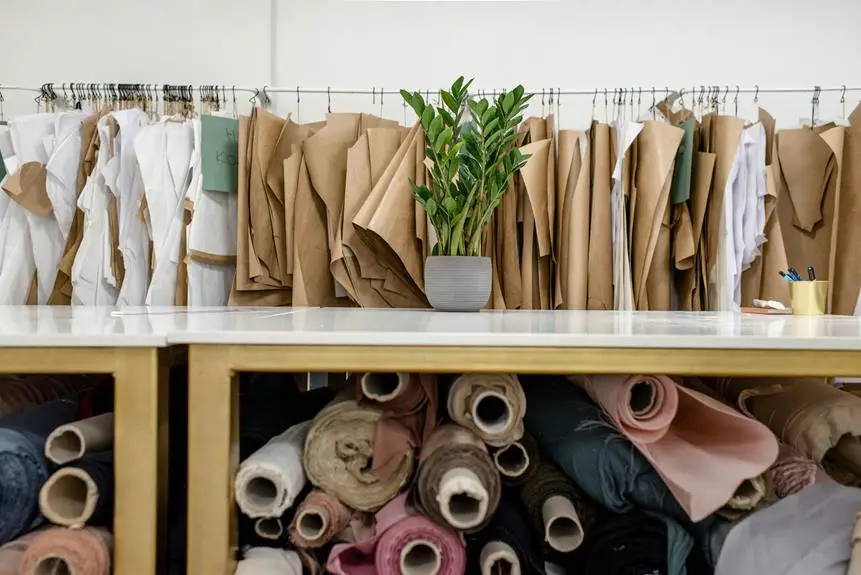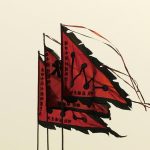You might find it intriguing to consider how damask, with its rich history, is adapting to the demands of today's textile industry. As sustainability becomes a priority and technology advances, the way you perceive and utilize damask could shift dramatically. Innovations like digital printing and smart textiles promise to transform traditional designs into modern statements. But what does this mean for the future of craftsmanship and consumer choices? The answers could redefine not just damask, but the entire fabric landscape.
Table of Contents
Historical Significance of Damask
Damask has played a pivotal role in textile history, showcasing intricate designs and luxurious textures that have captivated artisans and consumers alike for centuries. You'll find that its origins trace back to ancient China, where the complex weaving techniques first emerged. As trade routes expanded, these exquisite fabrics made their way to Europe, where they became symbols of wealth and sophistication.
You can't overlook the significance of damask during the Middle Ages and the Renaissance. It adorned the homes of nobility and was often used in ceremonial garments. The patterns, usually floral or geometric, demonstrated not just craftsmanship but also the cultural identity of the time.
You may also notice that damask fabrics were a preferred choice for tapestries and wall hangings, showcasing their versatility and enduring appeal.
As you explore the historical significance of damask, remember its influence on fashion and interior design. It's not just a fabric; it represents an evolution of artistry and craftsmanship through the ages.
Damask's rich history continues to inspire contemporary designers, ensuring that its legacy remains woven into the fabric of the textile industry today.
Technological Innovations in Weaving
Recent advancements in weaving technology have revolutionized the production of damask, allowing for more intricate designs and faster manufacturing processes.
You'll find that modern jacquard looms enable artisans to create complex patterns with precision and efficiency. These looms use computer software to control thread movement, resulting in stunning designs that were once too difficult or time-consuming to produce.
Additionally, the introduction of digital printing techniques complements traditional weaving, giving you the ability to customize damask fabrics with unique colors and styles. This flexibility means you can cater to diverse consumer preferences and stay ahead of market trends.
Moreover, automation in weaving processes has significantly reduced labor costs and production time. You can now produce larger quantities of high-quality damask fabrics without compromising on craftsmanship. This technology not only streamlines production but also enhances the overall quality of the finished product.
As you embrace these innovations, the possibilities for damask designs are virtually limitless. By integrating advanced weaving technologies, you're setting the stage for the future of damask in the textile industry, ensuring that this timeless fabric remains relevant and appealing to modern consumers.
Sustainable Practices in Textile Production
In today's textile industry, adopting sustainable practices is crucial for minimizing environmental impact and meeting consumer demand for eco-friendly products.
You can start by sourcing materials ethically, opting for organic fibers like cotton or linen that require fewer chemicals and water. This not only reduces pollution but also promotes biodiversity.
Next, consider implementing water-saving technologies in your production processes. Techniques like closed-loop water systems can significantly cut down water usage.
You should also explore energy-efficient machinery and renewable energy sources, such as solar or wind, to power your operations. This shift not only lowers your carbon footprint but can also lead to long-term cost savings.
Recycling and upcycling materials is another effective strategy. By reusing fabric scraps or repurposing old textiles, you minimize waste and contribute to a circular economy.
Additionally, educating your team about sustainable practices fosters a culture of responsibility and innovation within your organization.
Evolving Consumer Preferences
As sustainability reshapes the textile landscape, consumers are increasingly prioritizing eco-friendly and ethically produced products in their purchasing decisions. You may have noticed a shift in what people value when it comes to textiles, especially with classic materials like damask. Today's consumers want to know the story behind the products they buy. They look for transparency in production processes and materials, emphasizing the importance of sustainable sourcing.
You might find that consumers are also gravitating towards brands that promote fair labor practices and reduced environmental impact. This shift is encouraging manufacturers to adapt their practices and embrace more sustainable methods. It's not just about aesthetics anymore; it's about ethics and responsibility.
Moreover, consumers are leaning towards versatility and durability. They want textiles that not only look good but also stand the test of time. This preference aligns with a growing desire to invest in quality over quantity.
As you explore damask options, consider how your choices reflect these evolving consumer preferences. A well-made damask product that adheres to sustainable practices could resonate well with today's conscientious buyer, positioning you favorably in a competitive market.
Future Trends and Design Innovations
Emerging technologies and creative design approaches are set to redefine damask textiles, blending tradition with innovative aesthetics and functionality.
As you explore the future of damask, you'll notice an emphasis on sustainability. Eco-friendly materials and production methods are becoming standard, allowing you to enjoy beautiful textiles without compromising the environment.
Digital printing is also revolutionizing the design process. You can now customize patterns and colors with ease, creating unique damask pieces that reflect your personal style. This flexibility allows for a wide range of applications, from home decor to fashion.
Smart textiles are another exciting trend. Imagine damask fabrics that can change color or texture based on environmental conditions. This innovation can enhance both the aesthetic appeal and the functionality of your textiles, offering versatility that traditional damask can't match.
Frequently Asked Questions
What Are the Key Characteristics of Traditional Damask Fabric?
Traditional damask fabric features intricate patterns woven into the textile, showcasing a reversible design. It's often made from silk or linen, and you'll notice its luxurious sheen and soft texture, perfect for elegant drapery or upholstery.
How Does Damask Compare to Other Textile Weaves?
When you compare damask to other weaves, you'll notice its intricate patterns and reversibility. Unlike plain weaves, damask offers a luxurious texture, making it ideal for elegant decor and high-end fashion pieces.
Can Damask Be Used for Outdoor Applications?
Yes, you can use damask for outdoor applications, but it's essential to choose weather-resistant fabrics. These will help maintain the fabric's integrity and color, ensuring your outdoor decor remains beautiful and functional despite the elements.
What Maintenance Is Required for Damask Fabrics?
To maintain damask fabrics, you should regularly vacuum to remove dust, spot clean stains immediately, and avoid direct sunlight to prevent fading. Washing by hand or dry cleaning is best for preserving its beauty and integrity.
Are There Any Famous Designers Known for Damask Creations?
Yes, several famous designers are known for their damask creations. You'll find exquisite works by designers like Valentino and Oscar de la Renta, who've incorporated this rich fabric into their luxurious collections, showcasing its timeless elegance.
- How Does Ring Spun Cotton Affect Garment Fit and Shape Retention? - August 13, 2024
- What Are the Challenges in Producing Ring Spun Cotton? - August 13, 2024
- Is Ring Spun Cotton Suitable for Plus-Size Clothing? - August 13, 2024






